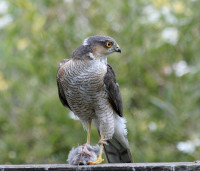A missing predator: Sparrowhawks absent from gardens this winter
23 Feb 2017 | No. 2017-08
It’s been a year of mixed fortunes for Sparrowhawk, with the highest recorded average counts in gardens last January, followed by the lowest-ever numbers for December, as reported by British Trust for Ornithology’s (BTO) Garden BirdWatch survey.
Sparrowhawks are most frequently seen in gardens during the autumn and winter months, a time when numbers are swelled with juveniles and when the smaller birds they prey on are flocking into gardens to feed. January 2016 saw the highest average counts of Sparrowhawk for the time of year but since summer 2016 numbers have been abnormally low, according to Garden BirdWatch. They were only seen in 8% of gardens in December, well below average and a 5% reduction on December 2015.
We suspect that this decline is linked to the wet weather in June. This resulted in a poor breeding season for many smaller birds, on which Sparrowhawks will feed, such as Blue Tits and Great Tits. With fewer young birds around there would have been less available food to feed their own chicks, potentially leading to lower survival in young Sparrowhawks. They may also have been directly affected by the wet weather.
Sparrowhawks are not always popular garden visitors, as they feed on other garden birds. Their population crashed in the 1950s and 1960s due to pesticide poisoning, but numbers have since recovered, and they are the bird of prey most commonly seen in gardens.
We do not yet know whether this sudden Sparrowhawk decline will be a continuing trend. You can help us find out by joining the BTO Garden BirdWatch survey and giving a small amount of time each week to monitor your garden wildlife.
Claire Boothby, Garden BirdWatch Development Officer at the British Trust for Ornithology said, “The surprise appearance of a Sparrowhawk is always a dramatic garden event and one that has been witnessed by fewer people than usual this winter. Sparrowhawks rely on the availability of prey, in their case particularly birds, to survive. We know that numbers of Great Tits and Blue Tits are down in gardens this year, following a poor breeding season and this may have had an effect on the number of Sparrowhawk seen in gardens.”
To help the BTO by taking part in Garden BirdWatch please visit www.bto.org/gbw, or get in touch by emailing gbw [at] bto.org (), telephoning 01842 750050 (Mon-Fri 9am-5:30pm).
Contact Details
Claire Boothby
(Garden BirdWatch Development Officer)
Office:
(9am to 5:30pm)
Email: claire.boothby [at] bto.org ()
Kate Risely
(Garden BirdWatch Organiser)
Office:
9am to 5:30pm
Email: kate.risely [at] bto.org ()
Paul Stancliffe
(BTO Press Officer)
Office: 01842 750050
(9am to 5:30pm)
Mobile: 07585440910
Email: press [at] bto.org ()
Images are available for use alongside this News Release. Please contact images [at] bto.org quoting reference February 2017 - 08.
The BTO has an ISDN line available for radio interviews. Please contact us to book an interview. Office:01842 750050.
Notes to editors
- The BTO is the UK’s leading bird research organisation. Over 30,000 birdwatchers contribute to the BTO’s surveys. They collect information that forms the basis of conservation action in the UK. The BTO maintains a staff of 100 at its offices in Thetford, Stirling, Bangor (Wales) and Bangor (Northern Ireland), who analyse and publicise the results of project work. The BTO’s investigations are funded by government, industry and conservation organisations. www.bto.org
- BTO Garden BirdWatch have a leaflet Sparrowhawks and Gardens Birds, a copy of which can be found online: www.bto.org/sites/default/files/u23/downloads/pdfs/sparrowhawk_leaflet_final_2014_web_version.pdf
BTO have a series of identification videos including one showing the difference between Sparrowhawk and Goshawk : www.bto.org/about-birds/bird-id/bto-bird-id-goshawk-and-sparrowhawk - The Garden BirdWatch survey is organised by the British Trust for Ornithology and is carried out by volunteer birdwatchers throughout the UK and has been going since 1994. The survey captures weekly data on birds and other wildlife throughout the year. More information can be found at: www.bto.org/gbw
- Garden BirdWatch results are available online and can be found at: www.bto.org/volunteer-surveys/gbw/results/annual-patterns-garden-use
- Nest Record Scheme organised by the British Trust for Ornithology found the lowest number of eggs per nest for Blue Tits this season since records began (1939). The Preliminary results can be found: www.bto.org/ces-preresults-2016
- Constant Effort Sites scheme organised by British Trust for Ornithology, found reduced abundance of juvenile Blue Tits and Great Tits in 2016 compared to the average of the last five years. The preliminary results can be found: www.bto.org/ces-preresults-2016







Share this page